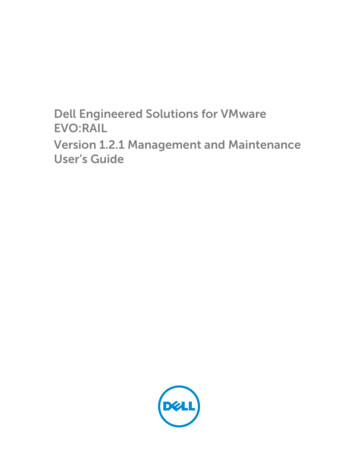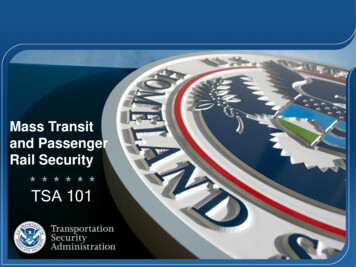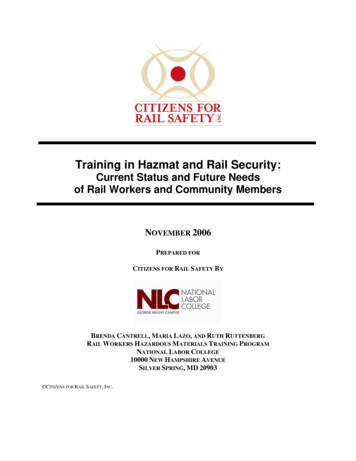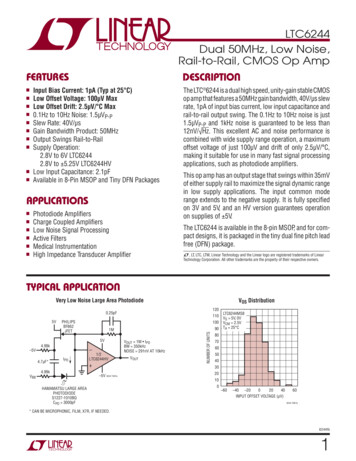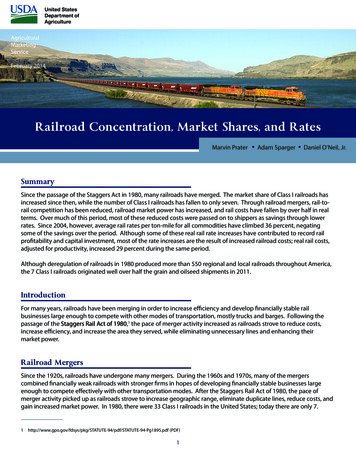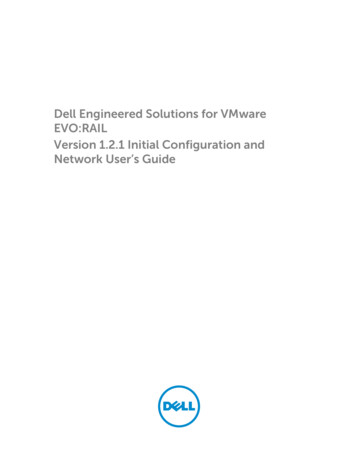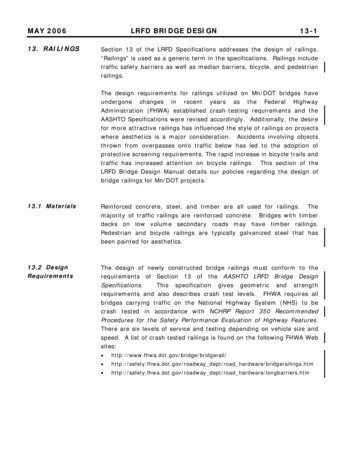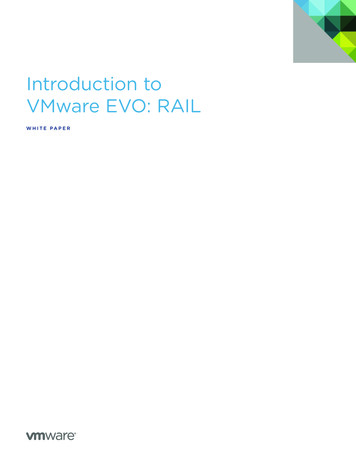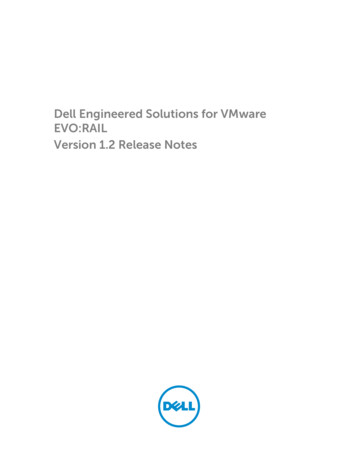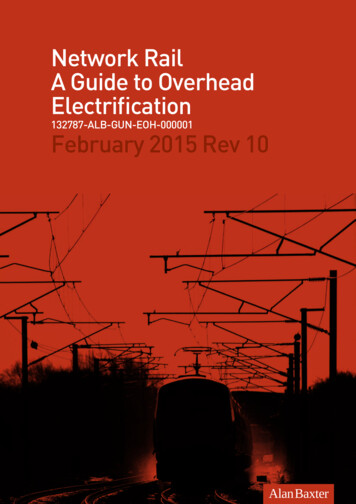
Transcription
Network RailA Guide to bruary 2015 Rev 10Alan Baxter
Network RailA Guide to bruary 2015 Rev 10Contents1.0Introduction 12.0Definitions 23.0Why electrify? 44.0A brief history of rail electrification in the UK 55.0The principles of electrically powered trains 66.0Overhead lines vs. third rail systems 77.0Power supply to power use: the four stages of powering trains by OLE 88.0The OLE system 109.0The components of OLE equipment 1210.0 How OLE equipment is arranged along the track 1711.0 Loading gauges and bridge clearances 2412.0 The safety of passengers and staff 2813.0 Installing OLE on different types of structure 3214.0 Conclusion 48Alan Baxter
ThursoExisting overhead line electrificationWickExisting third rail networkCommitted overhead line projectsProposed route of HS2‘Electric Spine’ conceptInvernessKyle hStirlingGlasgowEdinburghBerwick Upon terCambridgeFishguard lisburySouthamptonExeterPlymouthPenzanceNetwork Rail’s nationwide electrification programme, and the route of HS2HastingsBrighton
1.0IntroductionOverhead Line Equipment – or OLE – is the name railway engineers give to the assembly of masts, gantries andwires found along electrified railways.All this steel and cable has only one purpose – to supply power to make electric trains move.Operationally, environmentally and from the perspective of passenger service and comfort, OLE is now thepreferred means of powering trains throughout the world. For example, when the High Speed line from StPancras to Paris was built, there was only one choice for the engineers: OLE.But there is no doubt that it can be visually intrusive, and installing it on existing lines can require alterations tobridges, stations and other structures.OLE is also undeniably complex and frankly baffling to the lay person.The document has been written for the non-specialist, not the expert, and explains with the aid of diagramshow OLE works and why it has to look the way it does.Most importantly, it explains in ways we can all understand what is and what is not technically and legallypossible – from attaching OLE to listed stations and putting up masts on prominent viaducts, to getting wiresunder historic bridges and through famous tunnels .We hope you find this useful. You may even find it interesting!Alan BaxterNetwork Rail Guide to Overhead Electrification 132787-ALB-GUN-EOH-000001 / February 2015 Rev 101.0 IntroductionThe purpose of this guide, therefore, is to help all those with an interest in the current Network Railelectrification projects – whatever that interest may be – to understand why the line is being electrified, andwhy some changes to existing structures are required. It has been produced by Alan Baxter & Associates onbehalf of Network Rail with information supplied by, and with the assistance of, a number of the company’sengineers. Its contents have been reviewed and signed-off by Network Rail.1 of 52
2.0DefinitionsThe intention of this guide is to explain OLE to a non-technical audience. To that end, we have tried whereverpossible to describe electrification in non-professional terms. However, it is impossible to discuss OLE withoutusing some technical language. This glossary explains what these terms mean. The diagram on the followingpage illustrates many of them:Alternating Current (AC)Electrical current that changes direction 50 times per second.2.0 DefinitionsAutotransformer Feeder System System to be used for supplying power to the OLE. Incorporates ATF(ATF)cables, generally one per track, attached to OLE masts and connected toautotransformer stations at intervals alongside the track.2 of 52CantileverOLE structure comprising horizontal or near horizontal members supportingthe catenary projecting from a single mast on one side of the track (seediagram on opposite page).CatenaryThe longitudinal wire that supports the contact wire.ConductorAny insulated wire, cable or bar that carries electric current.Contact wireCarries the electricity which is supplied to the train by its pantograph.Contact & catenary wiretensioningIn order to keep the wires taut, they are in lengths of no more than c.1500m,and tensioned at each end.Direct Current (DC)Electrical current that flows in one direction, like that from a battery.DropperWires suspended vertically from the catenary at regular intervals to supportthe contact wire.Feeder stationA facility next to National Grid electricity transmission lines that extracts25,000V and transmits it to the railway. The spacing of these stationsdepends on the electrification system used.InsulatorsComponents that separate electrically live parts of the OLE from otherstructural elements and the earth. Traditionally ceramic, today they are oftensynthetic materials.Kinematic envelopeThe space that defines the train and all its allowable movements - rocking,swaying, bouncing, for example.Loading gauge (vehicle gauge)The dimensions – height and width – to which trains must conform in orderto avoid colliding with line-side structures such as bridges and platforms.MastTrackside column, normally steel, that supports the OLE.Mid point anchorAt the midpoint of the standard length of OLE wires, the wires are fixed inposition to keep the contact wire stable.Network Rail Guide to Overhead Electrification 132787-ALB-GUN-EOH-000001 / February 2015 Rev 10Alan Baxter
A length of electrically isolated or non-conducting material incorporatedinto the contact wire to completely separate electrical sections of OLE. It maytake the form of a short insertion in the contact wire or that of an extendedoverlap.OLEOverhead line electrification equipment, which supplies electric power to thetrains.OverlapEach length of the contact wire overlaps with the next so that the pantographslides smoothly from one to the other.PantographThe device on top of the train that collects electric current from the contactwire to power the train.Structure gaugeThe defined space into which a structure must not intrude, to avoid trainscolliding with it. This is larger than the kinematic envelope and loading gauge.Third rail systemRailway electrification system using a third rail located alongside the track tosupply DC power to the trains. No longer permitted for new installations onnational railways.2.0 DefinitionsNeutral sectionInsulatorAuto transformer feeder (ATF)Earth wireCatenaryPull-off arm(goose neck)Swivel fasteningInsulatorMastCantileverContact wireRegistration armAn example of an OLE mast, cantilever and associated equipment (in this case, ‘Series 1’)Alan BaxterNetwork Rail Guide to Overhead Electrification 132787-ALB-GUN-EOH-000001 / February 2015 Rev 103 of 52
3.0Why electrify?An efficient railway system that provides sufficient capacity for the future growth of both passenger and freighttraffic is fundamental to creating the robust national infrastructure necessary for a successful, competitive andsustainable economy. In the last fifteen years passenger journeys have increased by nearly 100% and freight by60%. They continue to grow. We need to provide extra capacity for this now if we are not to hinder economicgrowth in the future.At the moment, all trains on un-electrified routes are powered by diesel engines, similar in concept if not size tothose under the bonnets of many lorries. However, electrification is preferred for major railway lines becauseelectric trains are lighter, cleaner, cheaper, quieter and faster to accelerate. They allow more trains to be runmore efficiently and more quickly.3.0 Why electrify?Electric trains are cheaper than diesel trains because: they are cheaper to build and 20% cheaper to lease maintenance costs are typically 33% lower fuel costs are typically 45% lower because electric trains are lighter and more efficient and electricity fromthe National Grid is cheaper than diesel fuel electric trains are lighter and therefore cause on average 13% less wear to the tracks track maintenance costs are therefore lowerElectric trains are environmentally superior because: they do not pollute the air during operation power stations generating the electricity are more efficient and have more sophisticated and effectiveemissions controls they therefore emit on 20-30% less carbon per passenger mile than diesel they are quieterElectric trains are more comfortable because: they are quieter and vibrate less due to the absence of diesel enginesElectric trains provide a better service because: they have a higher power-to-weight ratio, which means that they are generally faster than diesel trains they accelerate more quickly, which reduces the journey timesFor all these reasons, the Government has made completing the electrification of the most heavily used mainlines in England some of its most important infrastructure projects, and has committed to running the firstelectric trains from London to Bristol by the end of 2016, from London to Nottingham and Sheffield by 2020 andbetween Leeds and Manchester by 2018.4 of 52Network Rail Guide to Overhead Electrification 132787-ALB-GUN-EOH-000001 / February 2015 Rev 10Alan Baxter
4.0A brief history of rail electrification in the UKFrom the birth of the railways in the early 19th century until the 1950s, steam locomotives were the dominantform of motive power on Britain’s railways. They were finally phased out by 1968.Diesel power – pioneered in America – started to become widespread in the 1950s. On the Great Western andMidland Main Lines this is still how long-distance services are powered – either in the form of locomotives at bothends of the train, like High Speed Trains, or where a number of smaller diesel engines are distributed underneathcarriages, as found on many other trains (see drawing below).Electrically powered trains have a much longer history in the UK, beginning with the London Underground in1890. This was - and still is - powered by a direct current system.Long-distance mainline 25,000V AC OLE systems are more recent. They are a product of the ModernisationPlan that swept steam away from the 1960s. First, the West Coast Main Line from Euston to the North West,in the 1960s and ‘70s, followed by the East Anglian Main Line in the 1980s, and then the East Coast Main Line,completed in 1990.OLE was introduced to the eastern end of the Great Western Main Line in the late 1990s to power the HeathrowExpress, and is being extended as far as Maidenhead for the trans-London Crossrail service. The Great WesternMain Line electrification project will extend this to Newbury, Oxford, Bristol and Cardiff by 2017.On the Midland Main Line, electrification from London to Bedford was installed in the 1980s. The Midland MainLine electrification project will extend this to Nottingham and Sheffield by 2020.In the Lancashire-Yorkshire corridor, electrification between Liverpool and Manchester is under constructionat the time of writing and is due for completion in 2015. The Northern Trans-Pennine electrification project willcontinue this to Leeds and York by the end of the decade.4.0 A brief history of rail electrification in the UKThe first OLE systems appeared before the First World War in south London and Lancashire (using 6,600V DC), andothers followed in East London and on Merseyside in the 1920s and 30s. But the first major network was created bythe Southern Railway from the 1920s. This is the 750V DC third rail system that still powers trains throughout theSouth East.Steam LocomotiveDiesel LocomotiveDiesel with under-slung engines (DMU - Diesel Multiple Unit)Electric Train (EMU - Electric Multiple Unit)Alan BaxterUnder-slung engines under each coachElectric motors on some or all coachesNetwork Rail Guide to Overhead Electrification 132787-ALB-GUN-EOH-000001 / February 2015 Rev 105 of 52
5.0The principles of electrically powered trainsIn its simplest terms, the electric train power system consists of a power supply wired to an electric motor in thetrain that drives the train’s wheels.To complete the circuit and thereby allow the current to flow, the track is used to make the return connection.As part of this circuit, the single purpose of OLE is to supply electricity to the moving trains.5.0 The principles of electrically powered trainsThis power supply must be something that trains can access at all times. The key objective of OLE designers isthus to ensure uninterrupted uniform, reliable and safe supply of power to trains. PowerSupplyVoltageElectric Motor-CurrentPrinciple CurrentVoltageControlMotor drives wheelsCurrent goes through thewheels to trackThe principle applied via OLE6 of 52Network Rail Guide to Overhead Electrification 132787-ALB-GUN-EOH-000001 / February 2015 Rev 10Alan Baxter
6.0Overhead lines vs. third rail systemsOLE can undoubtedly be visually intrusive and may require alterations to existing bridges and stations. For thisreason, the third rail system has sometimes been suggested as an alternative for sensitive landscapes or historicareas.In railway terms, however, the third rail system is now obsolete, and there is a long term objective to replaceit with OLE systems. Legislation governing the ability to operate international trains across the Europeannetworks only permits the installation of further OLE systems, not third rail ones. it is not possible to run trains faster than 110mph (160kph) it requires 20% more electricity to power trains compared with OLE it requires substations at closer intervals (every 8km) than for OLE (every 40-60km) it is much more susceptible to service disruption caused by rain, snow, ice or leaf fall its long-term maintenance and renewal costs are greater than OLE the public, trespassers and track workers are at ten times more risk of being electrocuted on third rail linesthan by OLE systemsOverhead line electrification (photograph: Bill Welsh)Alan Baxter6.0 Overhead lines vs.third rail systemsOther reasons for not using third rail electrification include:Third rail electrification (photograph: MalcolmMcDonald)Network Rail Guide to Overhead Electrification 132787-ALB-GUN-EOH-000001 / February 2015 Rev 107 of 52
7.0Power supply to power use:the four stages of powering trains by OLE7.1 The Four StagesThe supply of electricity to power trains is divided into 4 stages:1. power generation2. power transmission3. power feeding4. power collectionPower is generated at an electricity generating source – normally a power station - and then transmitted viatransformers into overhead transmission lines at high voltage (approximately 400,000V) - the National Grid.7.0 Power supply to power useThe supply is alternating current (AC). AC is more economical and practical to transmit over long distances thandirect current because it suffers from smaller losses. High voltages means smaller wires: to transmit the samepower at low voltage needs high currents and therefore large conductors (wires).Power is taken from the National Grid at feeder substations located next to the transmission lines, whichreduce the voltage to 25,000V and transmit the power to the OLE. Although it is more economical to transmitelectricity at higher voltages as the voltage grows the required clearances increase as does the cost of theequipment. Therefore, it has been found that 25,000V is the optimum voltage for main line trains.Masts and gantries support the overhead wire carrying the power - the contact wire. The power istransmitted from the contact wire to the train by a sprung ‘pantograph’, which is attached to the roof of themoving train. In the train, the current is used to drive the motors with the aid of on-board controllers.Power supply companysubstation transformerreduces power to 25,000VOLENetwork Rail controlStructureswitch room (on/off)25,000VAuto transformerContact wirefeeder stationfeeding trainwith 25,000VTransformerReturn1. Powergeneration2. Power transmission(National Grid approx.400,000V)3. Power feeding25,000V4. Power collectionFour stages of power generation and supply8 of 52Network Rail Guide to Overhead Electrification 132787-ALB-GUN-EOH-000001 / February 2015 Rev 10Alan Baxter
7.2 Completing the circuitThere has to be a closed electrical circuit in order for the current to flow and the train to move. The circuitcan be completed through the train wheels to the rails and then by connecting the rails back to the feedersubstation. However, significant complications arise from power loss over long distances and safety-criticalinterference with signalling and telecommunication. Section 8.1 explains how power loss is tackled.7.3 AC and DC currentThe National Grid transmits at AC because it is more economical and practical to transmit high voltages longdistances. OLE in the UK uses AC too, but the older third rail system used extensively in the South East suppliesDC. Because OLE is elevated it can transmit higher voltages more safely and efficiently. The standard used inthe UK and most of Europe is 25,000V AC.Alan BaxterNetwork Rail Guide to Overhead Electrification 132787-ALB-GUN-EOH-000001 / February 2015 Rev 107.0 Power supply to power useThe power supply can be either direct current (DC) or alternating current (AC). AC changes direction 50 timesper second while DC always flows in the same direction.9 of 52
8.0The OLE system8.1 New technologyNew systems of OLE are being adopted on Britain’s railways. To the general public these will not lookappreciably different to the structures that we are used to, but this new equipment - known as Series 1, Series 2and Master Series – is intended to be adopted throughout the network for future electrification projects.These new systems are designed to meet European standards for the interoperability of trains across thecontinent, and also incorporates a number of technological advances. The wire tensioning system is improvedto reduce the likelihood of wires coming down in severe weather, which is a cause of significant disruption onthe East Coast Main Line, for example. The systems also require fewer wires.8.0 The OLE systemBut perhaps the most significant development in the context of this document is what is known as theAutotransformer System. This is the way that power is supplied from the National Grid via feeder substationsto the line. The existing system requires booster transformers positioned on the masts every 3-8 km along theline; a significant intrusion in the landscape. An Autotransformer System removes the need for these boostertransformers as well as substantially reducing the overall number of feeder substations required.Feeder substationevery 60kmATF wireContact wireAutotransformerEvery 5-8km-25kV 25kV50kVAvailableRailsAutotransformerboosts the power inthe contact wireElectro-magnetic fields aroundcables tend to cancel each otherout to reduce interferenceAutotransformerThe Autotransformer System10 of 52Network Rail Guide to Overhead Electrification 132787-ALB-GUN-EOH-000001 / February 2015 Rev 10Alan Baxter
8.2 Feeder stationsBecause of the extra voltage, using the Autotransformer System dramatically reduces the number of feederstations required. For example, electricity to the Great Western Main Line will be fed from only four feederstations: at Kensal Green in London, and Didcot, Melksham and Cardiff. Reducing the number of feeder stationsin this way reduces the impact of electrification on the landscape because fewer components, buildings andwires are required.Each feeder station generally feeds two separate electrical sections of the route as shown in the diagram.Neutral sections are provided in order to separate different circuits.The location of feeder stations on the Midland Main Line and the Transpennine route are currently beingfinalised.OxfordCardiffFeeder StationDidcotFeeder StationBristolReadingFeeder StationKensal GreenMarlowWindsorPaddingtonBath Spa MelkshamFeeder StationNeutral sectionCARDIFF25KvHenleyNational Grid (400kV)MELKSHAM25KvDIDCOT25Kv8.0 The OLE systemSwanseaKENSAL GREEN25KvLive sectionsNeutral SectionsLocation of feeder stations for the Great Western Main Line electrification projectAlan BaxterNetwork Rail Guide to Overhead Electrification 132787-ALB-GUN-EOH-000001 / February 2015 Rev 1011 of 52
9.0The components of OLE equipment9.1 OLE components and their purposeOverhead line equipment comprises a large number of standardised components.Most of them are there to achieve the principal aims of OLE designers: keeping the contact wire as stationary aspossible so that power can flow uninterrupted to the train; and minimising wear of the system.To achieve this, the contact wire is tensioned between support structures in such a way that it can withstanddeflection by high winds and extreme temperatures. This ensures that the current passes to the train in allweather, even at high speed.9.0 The components of OLE equipmentThe contact wire is suspended from vertical cables called droppers that are supported by a longitudinal cablecalled the catenary. The catenary and contact wire span between support structures – either masts or frames –which are normally spaced approximately 50m apart (although there is some flexibility in spacing).The wires themselves are normally about 1500m long and tensioned at either end. To ensure no loss of powerto the pantograph, adjoining sections of wire overlap for about 180m.In designing the supporting structures, the most important engineering consideration is the effect of highwinds, both along and across the tracks. The supports are made sufficiently stiff so that they do not deflectenough to impair current collection.Push-off support tocontact wireOLE support structurePantographPull-off support tocontact wireContact wire in a zigzag patternPath of pantographOLE in planTypically 50mCatenary DroppersOLE SupportsApprox.1.3mPantographContact wire (25,000V)OLE in elevation12 of 52Network Rail Guide to Overhead Electrification 132787-ALB-GUN-EOH-000001 / February 2015 Rev 10Alan Baxter
Stagger9.0 The components of OLE equipmentThe contact wire also runs in a zig-zag path above the track to avoid wearing a groove in the pantograph. Thezig-zag - known as the ‘stagger’ - is generally achieved by the use of ‘pull-off’ arms attached to the supportstructures.Stagger of contact wire and catenary. Note also the pantograph ontop of the train (photograph Graeme Bickerdike/Four by Three)Alan BaxterNetwork Rail Guide to Overhead Electrification 132787-ALB-GUN-EOH-000001 / February 2015 Rev 1013 of 52
9.2 Cantilever mastsWhere there are only one or two tracks, OLE is normally supported from lineside masts - typically made ofH-section steel - using cantilevers. The catenary cable and the pull/push-off arms supporting the contactwire are attached to the ends of the cantilever. Where the masts and cantilevers meet, insulators are requiredto separate the electrically live elements. The earth wire is normally attached to the mast.InsulatorAuto transformer feeder (ATF)Earth wireCatenaryPull-off arm(goose neck)Swivel fasteningInsulator9.0 The components of OLE equipmentMastCantileverContact wireRegistration armOLE mast, cantilever and associated equipment (in this case Series One)Newly installed Series Two OLE cantilever masts on the North West Electrification Project (photograph: MarkBarber)14 of 52Network Rail Guide to Overhead Electrification 132787-ALB-GUN-EOH-000001 / February 2015 Rev 10Alan Baxter
9.3 Portal framesWhere there are more than two tracks, cantilever masts are not always feasible. Instead, a steel frame may beadopted, spanning the tracks. This is generally referred to as a portal frame.The frame consists of masts joined by a horizontal boom, which might be H section or lattice steel as shown onthe diagram below.On frames, the cantilevers supporting the wires are attached to the boom by vertical members called drop tubes.CatenaryCantileverBoomDrop tubePull-off arm(goose neck)Contact wireInsulatorAuto transformer feeder (ATF)Registration armMastPortal frame OLE support structure9.0 The components of OLE equipmentEarthwireA typical portal frame made of H-section steel members (photograph: Network Rail)Alan BaxterNetwork Rail Guide to Overhead Electrification 132787-ALB-GUN-EOH-000001 / February 2015 Rev 1015 of 52
9.4 Headspans9.0 The components of OLE equipmentEarlier overhead electrification projects have frequently used a system of wires spanning between masts eitherside of the tracks to support the OLE catenary and contact wires. These are known as ‘headspans’. There havebeen difficulties with this system in practice, in particular because there is a much greater risk that damage tothe OLE will affect all tracks, resulting in much greater disruption than with other systems. As a consequence,headspans are now avoided, except in historic train sheds where slow train speeds reduce the risk of damage.Headspans are still favoured in these circumstances because they are much less visually obtrusive than othersupport methods (see section 13.6).Headspans at Hanwell Station, on the Great Western Main Line. These supports are no longer favoured exceptwhere trains move very slowly, such as depots or terminus stations (see section 13.6) (photograph: Alan Baxter &Associates)16 of 52Network Rail Guide to Overhead Electrification 132787-ALB-GUN-EOH-000001 / February 2015 Rev 10Alan Baxter
10.0How OLE equipment is arranged along the track10.1 TensioningThe catenary and contact wires are installed in lengths that are tensioned at either end in order to keep thecontact wire as still as possible. this is so that a good contact is maintained with the pantograph at all times andin all conditions. The tensioned wires will generally be up to 1500m long. An overlap between the length ofwires of up to 195m is needed in order to provide a continuous supply of electricity to the trains.up to 195m10.0 How OLE equipment is arranged along the track1200-1500m typicallyup to 195mPlanMid point anchor holds the wire in place.Tensioners at each end keep the wire tautCatenary and contact wirestensioned in 1200-1500m lengthsSectionTensioningLarger frames to resisttension in wiresStandard masts withpaired arms65m65m65mMaximum spacingsOverlappingAlan BaxterNetwork Rail Guide to Overhead Electrification 132787-ALB-GUN-EOH-000001 / February 2015 Rev 1017 of 52
The conventional tensioning mechanism consists of a braced mast and iron weights, as shown below.However, this system is susceptible to mechanical problems and to vandalism that can cause servicedisruptions. Therefore new systems use a spring tensioning mechanism, as shown here. Each wire needs twosprings at each end (one for the catenary and one for the contact wire) and these are attached above the trackto frames spanning the line. These supporting frames are larger than typical OLE structures because of thegreater forces at work.Catenary10.0 How OLE equipment is arranged along the trackContact wireMastBracingmemberCast iron weightsto tension theoverhead wiresCast-iron balance weights, as traditionally used on UK railwaysSpring tensioner forcatenary wireSpring tensioner forcontact wireBoomTerminatingcatenary wireTerminatingcontact wireMastContinuingcatenary wireContinuingcontact wireSpring tension device, as proposed for new electrification projects18 of 52Network Rail Guide to Overhead Electrification 132787-ALB-GUN-EOH-000001 / February 2015 Rev 10Alan Baxter
10.2 Mid-point anchorAt the midpoint along a tensioned length, the wires are fixed in place. This is called the midpoint anchor andits purpose is to resist the effect of the friction caused by the passing pantograph trying to drag the contactwire forward. Midpoint anchor structures are likely to be portal frames that are slightly bigger than typical OLEstructures.10.3 At cross-overs (points)This means that wherever there are points there have to be more and larger supporting structures andwires. This is exemplified by the approaches to major stations such as Euston or Paddington, where there is aprofusion of gantry supporting the OLE.Additional wires for crossoversOLE support structuresStructures closely spaced to guide the contact wire across tracks.These are located at the beginning and end of a crossoverOverhead wires tensionedto a support frame 50m10.0 How OLE equipment is arranged along the trackTo ensure a continuous supply of power when a train switches from one track to another across points, orcross-overs, additional wires are provided. These are normally
Alan Baxter Network Rail Guide to Overhead Electrification 132787-ALB-GUN-EOH-000001 / February 2015 Rev 10 3 of 52 2.0 Definitions Neutral section A length of electrically isolated or non-conducting material incorporated into the contact wire to completely separate electrical sections of OLE. It may take the form of a short insertion in the contact wire or that of an extended
